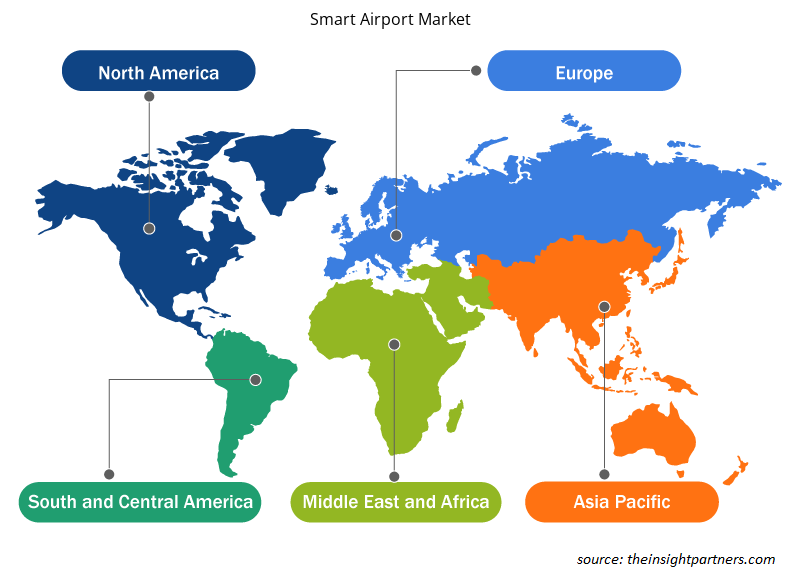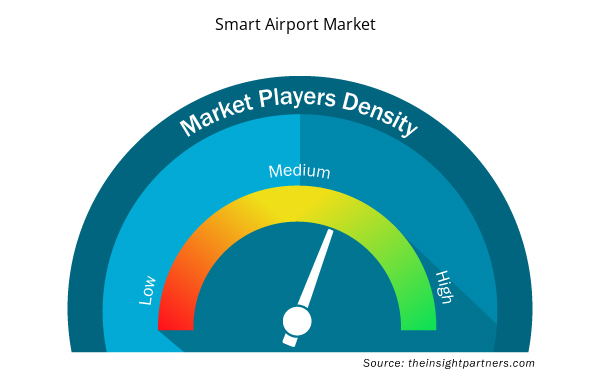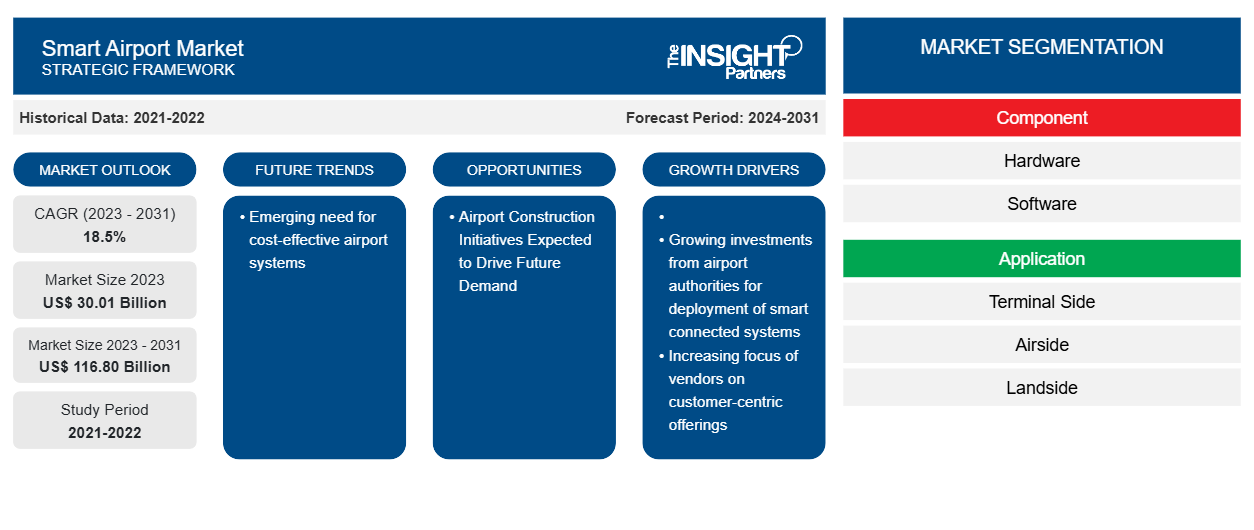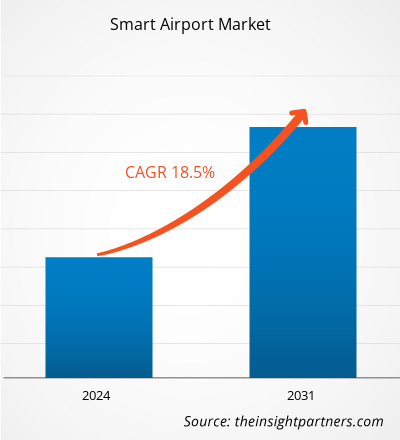Der Markt für intelligente Flughäfen soll von 30,01 Milliarden US-Dollar im Jahr 2023 auf 116,80 Milliarden US-Dollar im Jahr 2031 anwachsen. Der Markt wird zwischen 2023 und 2031 voraussichtlich eine durchschnittliche jährliche Wachstumsrate (CAGR) von 18,5 % verzeichnen. Der aufkommende Bedarf an kostengünstigen Flughafensystemen dürfte ein wichtiger Trend auf dem Markt bleiben.CAGR of 18.5% during 2023–2031. Emerging need for cost-effective airport systems is likely to remain a key trend in the market.
Marktanalyse für intelligente Flughäfen
Die Flughäfen nutzen Lösungen und Dienstleistungen von Herstellern intelligenter Flughafensysteme. Die Nachfrage nach automatisierten Systemen für intelligente Flughäfen steigt aufgrund steigender Investitionen in den Einsatz von KI- und ML-basierten Systemen an verschiedenen Flughäfen. Komponentenhersteller im Smart-Airport-Ökosystem haben kurzfristige und langfristige Verträge mit den Herstellern intelligenter Technologiegeräte wie intelligenten Datenverarbeitungssystemen , künstlicher Intelligenz-Biometrie, IoT-Sensoren, Modems, Routern und Peel-&-Stick-Sensoren abgeschlossen.Anbieter intelligenter Flughafensysteme sind Amadeus IT Group SA; Cisco System, Inc; Huawei Technologies Co., Ltd; Honeywell International Inc.; Indra Sistemas SA; SABRE GLBL Inc.; Jeppesen; Zensors und SITA. Diese Unternehmen bieten Endnutzern intelligente End-to-End-Geräte, -Dienste und -Lösungen. Zu den wichtigsten Endnutzern intelligenter Flughafensysteme zählen der Flughafen Singapur Changi, der Flughafen Seoul Incheon, die Flughäfen Houston, Tokio Haneda, der internationale Flughafen Hongkong, der internationale Flughafen Doha Hamad, der Flughafen München und die Flughäfen London Heathrow.
Marktübersicht für intelligente Flughäfen
Zu den wichtigsten Akteuren im Ökosystem des Smart-Airport-Marktes zählen Komponentenhersteller und -lieferanten, Softwareentwickler und -integratoren, Hersteller von Smart-Airport-Systemen und Endnutzer. Zu den Komponentenherstellern und -lieferanten zählen unter anderem Astronics Corporation, TE Connectivity, Molex, Panduit, Honeywell und Schneider Electric. Steigende staatliche Investitionen in den Aufbau intelligenter Flughäfen beschleunigen die Digitalisierung von Flughäfen. Sicherheit ist bei intelligenten Flughäfen von entscheidender Bedeutung. Daher arbeiten viele Smart-Airport-Behörden zusammen, um diese Einrichtungen zu sichern und ihre Betriebseffizienz zu verbessern.
Passen Sie diesen Bericht Ihren Anforderungen an
Sie erhalten kostenlos individuelle Anpassungen an jedem Bericht, einschließlich Teilen dieses Berichts oder einer Analyse auf Länderebene, eines Excel-Datenpakets sowie tolle Angebote und Rabatte für Start-ups und Universitäten.
- Holen Sie sich die wichtigsten Markttrends aus diesem Bericht.Dieses KOSTENLOSE Beispiel umfasst eine Datenanalyse von Markttrends bis hin zu Schätzungen und Prognosen.
Treiber und Chancen des Smart Airport-Marktes
Zunehmender Fokus der Marktanbieter auf kundenorientierte Angebote
Unternehmen in der Smart-Airport-Branche konzentrieren sich auf die Bereitstellung kundenorientierter Lösungen, um die Einführung intelligenter Flughafentechnologien zu fördern. Die Nachfrage der Passagiere nach Gepäckverfolgung steigt weltweit, was einer der Hauptschwerpunkte der Flughafenbehörden ist. Laut der Zivilluftfahrtbehörde Chinas (CAAC) wollten im Jahr 2021 etwa 75 % der Fluggäste in China Details zur Gepäckverfolgung und Abholzeit ihres Gepäcks erfahren. Laut derselben Studie konzentrieren sich etwa 86 % der Fluggesellschaften in China auf die Bereitstellung von Benachrichtigungen zur Gepäckverfolgung, und 57 % der Fluggesellschaften stellen ihren Passagieren in ganz China auch Informationen zur Gepäckabholung zur Verfügung. Daher konzentrieren sich Anbieter auf dem Smart-Airport-Markt darauf, Fluggesellschaften intelligente Gepäckverwaltungssysteme bereitzustellen, um ihre Geschäftsabläufe zu automatisieren und den Passagieren ein besseres Erlebnis zu bieten. Solche Systeme sind in Cloud-basierte Airline-Anwendungen und -Datenbanken integriert, Cloud-basierte Analysen und eine Machine-to-Machine- (M2M) und IoT-Plattform integriert, um Echtzeitdaten und Ereignisse von intelligentem Gepäck zu verbinden, zu verwalten und zu sichern. Darüber hinaus trägt der Einsatz von Gepäckmanagementsystemen in Flughäfen auch dazu bei, die Gesamtbetriebskosten zu senken und die Gesamtbetriebseffizienz zu steigern.IoT platform to connect, manage, and secure real-time data and events from smart luggage. Moreover, the deployment of baggage management systems in airports also helps to reduce the overall operational costs, along with boosting overall operational efficiencies.
Neue Flughafenbauprojekte
Der Anstieg der Zahl der Flughafenbauprojekte in Schwellenländern wie China und Indien dürfte in den kommenden Jahren neue Möglichkeiten für Marktanbieter schaffen. Mehrere Regierungspläne im Zusammenhang mit dem Bau neuer Flughäfen und der Erweiterung/Modernisierung bestehender Flughäfen sind weitere wichtige Faktoren, die den Einsatz intelligenter Flughafensysteme in den kommenden Jahren unterstützen dürften. So hat die indische Regierung beispielsweise bereits 2022 angekündigt, bis Ende 2025 220 Flughäfen bauen zu wollen. Darüber hinaus kündigte die Zivilluftfahrtbehörde der Volksrepublik China (CAAC) 2018 Pläne an, bis Ende 2035 216 neue Flughäfen zu bauen, wodurch die Gesamtzahl der Flughäfen bis 2035 auf 450 steigen wird (derzeit 2023 sind es 234 Flughäfen). Solche Projekte werden in den kommenden Jahren voraussichtlich neue Möglichkeiten für Unternehmen im Bereich intelligenter Flughafentechnologie schaffen.
Segmentierungsanalyse des Smart Airport-Marktberichts
Wichtige Segmente, die zur Ableitung der Marktanalyse für intelligente Flughäfen beigetragen haben, sind Komponenten und Anwendungen.
- Basierend auf den Komponenten ist der Markt für intelligente Flughäfen in Hardware und Software unterteilt. Das Hardwaresegment ist weiter unterteilt in Sicherheitssysteme, Kommunikations- und Navigationssysteme, Endgeräte und Datenspeichersysteme. Das Hardwaresegment hatte im Jahr 2023 einen größeren Marktanteil.
- Basierend auf der Anwendung ist der Markt für intelligente Flughäfen in Terminalseite, Luftseite und Landseite unterteilt. Das Segment Terminalseite hatte im Jahr 2023 einen größeren Marktanteil.
Marktanteilsanalyse für intelligente Flughäfen nach geografischer Lage
Der geografische Umfang des Marktberichts für intelligente Flughäfen ist hauptsächlich in fünf Regionen unterteilt: Nordamerika, Europa, Asien-Pazifik, Naher Osten und Afrika sowie Südamerika.
Der asiatisch-pazifische Raum dominierte den Markt im Jahr 2023, gefolgt von Europa und Nordamerika. Darüber hinaus wird der asiatisch-pazifische Raum in den kommenden Jahren voraussichtlich die höchste durchschnittliche jährliche Wachstumsrate verzeichnen. Der Haupttreiber für den Markt für intelligente Flughäfen im asiatisch-pazifischen Raum ist die Präsenz einer großen Anzahl intelligenter Flughafenprojekte in der gesamten Region. Einige der wichtigsten intelligenten Flughäfen im asiatisch-pazifischen Raum sind beispielsweise der internationale Flughafen Hongkong, der Flughafen Shenzhen, der internationale Flughafen Peking-Daxing, der Flughafen Tokio-Haneda, der internationale Flughafen Centrair Nagoya, der internationale Flughafen Neu-Delhi, der internationale Flughafen Hyderabad, der Flughafen Seoul Incheon, der Flughafen Jeju, der Flughafen Singapur Changi, der internationale Flughafen Kuala Lumpur und der Flughafen Indonesien. Darüber hinaus werden Länder wie China und Indien bis Ende 2035 voraussichtlich mehr als 400 Flughäfen bauen, was den Markt in den kommenden Jahren weiter ankurbeln dürfte.
Regionale Einblicke in den Smart Airport-Markt
Die regionalen Trends und Faktoren, die den Smart Airport-Markt im Prognosezeitraum beeinflussen, wurden von den Analysten von Insight Partners ausführlich erläutert. In diesem Abschnitt werden auch die Marktsegmente und die Geografie des Smart Airport-Marktes in Nordamerika, Europa, im asiatisch-pazifischen Raum, im Nahen Osten und Afrika sowie in Süd- und Mittelamerika erörtert.

- Erhalten Sie regionalspezifische Daten zum Smart Airport-Markt
Umfang des Marktberichts zum intelligenten Flughafen
| Berichtsattribut | Details |
|---|---|
| Marktgröße im Jahr 2023 | 30,01 Milliarden US-Dollar |
| Marktgröße bis 2031 | 116,80 Milliarden US-Dollar |
| Globale CAGR (2023 - 2031) | 18,5 % |
| Historische Daten | 2021-2022 |
| Prognosezeitraum | 2024–2031 |
| Abgedeckte Segmente | Nach Komponente
|
| Abgedeckte Regionen und Länder | Nordamerika
|
| Marktführer und wichtige Unternehmensprofile |
|
Marktteilnehmerdichte: Der Einfluss auf die Geschäftsdynamik
Der Markt für intelligente Flughäfen wächst rasant. Dies wird durch die steigende Nachfrage der Endnutzer aufgrund von Faktoren wie sich entwickelnden Verbraucherpräferenzen, technologischen Fortschritten und einem größeren Bewusstsein für die Vorteile des Produkts vorangetrieben. Mit der steigenden Nachfrage erweitern Unternehmen ihr Angebot, entwickeln Innovationen, um die Bedürfnisse der Verbraucher zu erfüllen, und nutzen neue Trends, was das Marktwachstum weiter ankurbelt.
Die Marktteilnehmerdichte bezieht sich auf die Verteilung von Firmen oder Unternehmen, die in einem bestimmten Markt oder einer bestimmten Branche tätig sind. Sie gibt an, wie viele Wettbewerber (Marktteilnehmer) in einem bestimmten Marktraum im Verhältnis zu seiner Größe oder seinem gesamten Marktwert präsent sind.
Die wichtigsten auf dem Smart Airport-Markt tätigen Unternehmen sind:
- Honeywell International Inc
- Cisco Systems Inc
- Huawei Technologies Co., Ltd
- Indra Sistemas SA
- Amadeus IT Group SA
- SITA
Haftungsausschluss : Die oben aufgeführten Unternehmen sind nicht in einer bestimmten Reihenfolge aufgeführt.

- Überblick über die wichtigsten Akteure auf dem Smart Airport-Markt
Neuigkeiten und aktuelle Entwicklungen zum Smart Airport-Markt
Der Markt für intelligente Flughäfen wird durch die Erhebung qualitativer und quantitativer Daten nach Primär- und Sekundärforschung bewertet, die wichtige Unternehmenspublikationen, Verbandsdaten und Datenbanken umfasst. Nachfolgend sind einige der Entwicklungen auf dem Markt für intelligente Flughäfen aufgeführt:
Thales hat von der Flughafenmanagementgruppe SEA (Società per azioni Esercizi Aeroportuali) den Auftrag erhalten, eine innovative digitale Plattformlösung zu liefern, die die Gruppe bei der Steigerung der Betriebseffizienz unterstützen soll. (Quelle: Thales, Pressemitteilung, März 2022)
- Während der ersten Airports Innovate Exhibition, die vom 20. bis 22. November in Maskat, Oman, stattfindet, stellte Huawei eine Reihe brandneuer intelligenter Flughafenlösungen für internationale Märkte vor, darunter die Fully Connected Fiber Network Solution und die Smart Airport Perimeter Security mit Fiber Sensing Solution. (Quelle: Huawei, Pressemitteilung, November 2023)
Abdeckung und Ergebnisse des Smart Airport-Marktberichts
Der Bericht „Smart Airport-Marktgröße und -prognose (2021–2031)“ bietet eine detaillierte Analyse des Marktes, die die folgenden Bereiche abdeckt:
- Marktgröße und Prognose für intelligente Flughäfen auf globaler, regionaler und Länderebene für alle wichtigen Marktsegmente, die im Rahmen des Berichts abgedeckt sind
- Markttrends und Marktdynamiken für intelligente Flughäfen wie Treiber, Einschränkungen und wichtige Chancen
- Detaillierte Porter-Fünf-Kräfte-Analyse
- Analyse des Smart-Airport-Marktes mit wichtigen Markttrends, globalen und regionalen Rahmenbedingungen, wichtigen Akteuren, Vorschriften und aktuellen Marktentwicklungen
- Branchenlandschaft und Wettbewerbsanalyse, einschließlich Marktkonzentration, Heatmap-Analyse, prominenten Akteuren und aktuellen Entwicklungen für den Smart-Airport-Markt
- Detaillierte Firmenprofile
- Historische Analyse (2 Jahre), Basisjahr, Prognose (7 Jahre) mit CAGR
- PEST- und SWOT-Analyse
- Marktgröße Wert/Volumen – Global, Regional, Land
- Branche und Wettbewerbsumfeld
- Excel-Datensatz



Report Coverage
Revenue forecast, Company Analysis, Industry landscape, Growth factors, and Trends

Segment Covered
This text is related
to segments covered.

Regional Scope
North America, Europe, Asia Pacific, Middle East & Africa, South & Central America

Country Scope
This text is related
to country scope.
Häufig gestellte Fragen
Asia Pacific region dominated the smart airport market in 2023.
Growing investments from airport authorities for deployment of smart connected systems and increasing focus of vendors on customer-centric offerings are some of the factors driving the growth for smart airport market.
Emerging need for cost-effective airport systems is one of the major trends of the market.
Honeywell International Inc, Cisco Systems Inc, Huawei Technologies Co Ltd, Indra Sistemas SA, Amadeus IT Group SA, SITA, Collins Aerospace, Daifuku Co Ltd, Thales Group, and T-Systems International GmbH are some of the key players profiled under the report.
The estimated value of the smart airport market by 2031 would be around US$ 116.80 billion.
The smart airport market is likely to register of 18.5% during 2023-2031.
Trends and growth analysis reports related to Aerospace and Defense : READ MORE..
The Insight Partners performs research in 4 major stages: Data Collection & Secondary Research, Primary Research, Data Analysis and Data Triangulation & Final Review.
- Data Collection and Secondary Research:
As a market research and consulting firm operating from a decade, we have published and advised several client across the globe. First step for any study will start with an assessment of currently available data and insights from existing reports. Further, historical and current market information is collected from Investor Presentations, Annual Reports, SEC Filings, etc., and other information related to company’s performance and market positioning are gathered from Paid Databases (Factiva, Hoovers, and Reuters) and various other publications available in public domain.
Several associations trade associates, technical forums, institutes, societies and organization are accessed to gain technical as well as market related insights through their publications such as research papers, blogs and press releases related to the studies are referred to get cues about the market. Further, white papers, journals, magazines, and other news articles published in last 3 years are scrutinized and analyzed to understand the current market trends.
- Primary Research:
The primarily interview analysis comprise of data obtained from industry participants interview and answers to survey questions gathered by in-house primary team.
For primary research, interviews are conducted with industry experts/CEOs/Marketing Managers/VPs/Subject Matter Experts from both demand and supply side to get a 360-degree view of the market. The primary team conducts several interviews based on the complexity of the markets to understand the various market trends and dynamics which makes research more credible and precise.
A typical research interview fulfils the following functions:
- Provides first-hand information on the market size, market trends, growth trends, competitive landscape, and outlook
- Validates and strengthens in-house secondary research findings
- Develops the analysis team’s expertise and market understanding
Primary research involves email interactions and telephone interviews for each market, category, segment, and sub-segment across geographies. The participants who typically take part in such a process include, but are not limited to:
- Industry participants: VPs, business development managers, market intelligence managers and national sales managers
- Outside experts: Valuation experts, research analysts and key opinion leaders specializing in the electronics and semiconductor industry.
Below is the breakup of our primary respondents by company, designation, and region:

Once we receive the confirmation from primary research sources or primary respondents, we finalize the base year market estimation and forecast the data as per the macroeconomic and microeconomic factors assessed during data collection.
- Data Analysis:
Once data is validated through both secondary as well as primary respondents, we finalize the market estimations by hypothesis formulation and factor analysis at regional and country level.
- Macro-Economic Factor Analysis:
We analyse macroeconomic indicators such the gross domestic product (GDP), increase in the demand for goods and services across industries, technological advancement, regional economic growth, governmental policies, the influence of COVID-19, PEST analysis, and other aspects. This analysis aids in setting benchmarks for various nations/regions and approximating market splits. Additionally, the general trend of the aforementioned components aid in determining the market's development possibilities.
- Country Level Data:
Various factors that are especially aligned to the country are taken into account to determine the market size for a certain area and country, including the presence of vendors, such as headquarters and offices, the country's GDP, demand patterns, and industry growth. To comprehend the market dynamics for the nation, a number of growth variables, inhibitors, application areas, and current market trends are researched. The aforementioned elements aid in determining the country's overall market's growth potential.
- Company Profile:
The “Table of Contents” is formulated by listing and analyzing more than 25 - 30 companies operating in the market ecosystem across geographies. However, we profile only 10 companies as a standard practice in our syndicate reports. These 10 companies comprise leading, emerging, and regional players. Nonetheless, our analysis is not restricted to the 10 listed companies, we also analyze other companies present in the market to develop a holistic view and understand the prevailing trends. The “Company Profiles” section in the report covers key facts, business description, products & services, financial information, SWOT analysis, and key developments. The financial information presented is extracted from the annual reports and official documents of the publicly listed companies. Upon collecting the information for the sections of respective companies, we verify them via various primary sources and then compile the data in respective company profiles. The company level information helps us in deriving the base number as well as in forecasting the market size.
- Developing Base Number:
Aggregation of sales statistics (2020-2022) and macro-economic factor, and other secondary and primary research insights are utilized to arrive at base number and related market shares for 2022. The data gaps are identified in this step and relevant market data is analyzed, collected from paid primary interviews or databases. On finalizing the base year market size, forecasts are developed on the basis of macro-economic, industry and market growth factors and company level analysis.
- Data Triangulation and Final Review:
The market findings and base year market size calculations are validated from supply as well as demand side. Demand side validations are based on macro-economic factor analysis and benchmarks for respective regions and countries. In case of supply side validations, revenues of major companies are estimated (in case not available) based on industry benchmark, approximate number of employees, product portfolio, and primary interviews revenues are gathered. Further revenue from target product/service segment is assessed to avoid overshooting of market statistics. In case of heavy deviations between supply and demand side values, all thes steps are repeated to achieve synchronization.
We follow an iterative model, wherein we share our research findings with Subject Matter Experts (SME’s) and Key Opinion Leaders (KOLs) until consensus view of the market is not formulated – this model negates any drastic deviation in the opinions of experts. Only validated and universally acceptable research findings are quoted in our reports.
We have important check points that we use to validate our research findings – which we call – data triangulation, where we validate the information, we generate from secondary sources with primary interviews and then we re-validate with our internal data bases and Subject matter experts. This comprehensive model enables us to deliver high quality, reliable data in shortest possible time.


 Holen Sie sich ein kostenloses Muster für diesen Bericht
Holen Sie sich ein kostenloses Muster für diesen Bericht